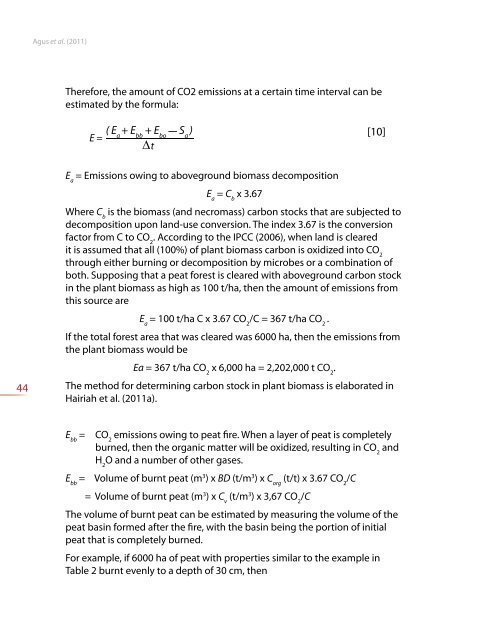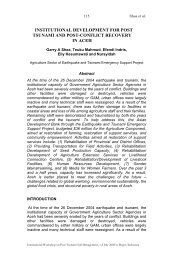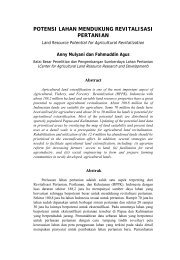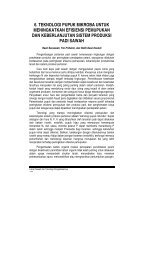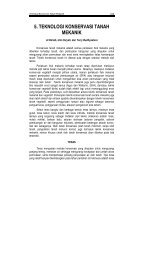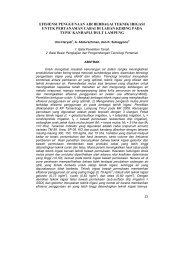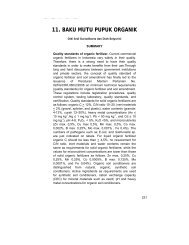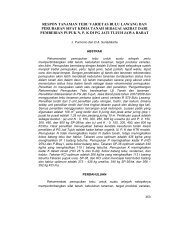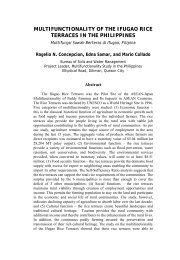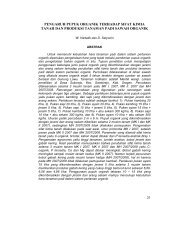Measuring carbon stock in peat soils - Balai Penelitian Tanah
Measuring carbon stock in peat soils - Balai Penelitian Tanah
Measuring carbon stock in peat soils - Balai Penelitian Tanah
You also want an ePaper? Increase the reach of your titles
YUMPU automatically turns print PDFs into web optimized ePapers that Google loves.
44<br />
Agus et al. (2011)<br />
Therefore, the amount of CO2 emissions at a certa<strong>in</strong> time <strong>in</strong>terval can be<br />
estimated by the formula:<br />
E =<br />
( E a + E bb + E bo — S a )<br />
t<br />
E = Emissions ow<strong>in</strong>g to aboveground biomass decomposition<br />
a<br />
E = C x 3.67<br />
a b<br />
[10]<br />
Where C b is the biomass (and necromass) <strong>carbon</strong> <strong>stock</strong>s that are subjected to<br />
decomposition upon land-use conversion. The <strong>in</strong>dex 3.67 is the conversion<br />
factor from C to CO 2 . Accord<strong>in</strong>g to the IPCC (2006), when land is cleared<br />
it is assumed that all (100%) of plant biomass <strong>carbon</strong> is oxidized <strong>in</strong>to CO 2<br />
through either burn<strong>in</strong>g or decomposition by microbes or a comb<strong>in</strong>ation of<br />
both. Suppos<strong>in</strong>g that a <strong>peat</strong> forest is cleared with aboveground <strong>carbon</strong> <strong>stock</strong><br />
<strong>in</strong> the plant biomass as high as 100 t/ha, then the amount of emissions from<br />
this source are<br />
E = 100 t/ha C x 3.67 CO /C = 367 t/ha CO .<br />
a 2 2<br />
If the total forest area that was cleared was 6000 ha, then the emissions from<br />
the plant biomass would be<br />
Ea = 367 t/ha CO x 6,000 ha = 2,202,000 t CO .<br />
2 2<br />
The method for determ<strong>in</strong><strong>in</strong>g <strong>carbon</strong> <strong>stock</strong> <strong>in</strong> plant biomass is elaborated <strong>in</strong><br />
Hairiah et al. (2011a).<br />
E = CO emissions ow<strong>in</strong>g to <strong>peat</strong> fire. When a layer of <strong>peat</strong> is completely<br />
bb 2<br />
burned, then the organic matter will be oxidized, result<strong>in</strong>g <strong>in</strong> CO and 2<br />
H O and a number of other gases.<br />
2<br />
E = Volume of burnt <strong>peat</strong> (m bb 3 ) x BD (t/m3 ) x C (t/t) x 3.67 CO /C<br />
org 2<br />
= Volume of burnt <strong>peat</strong> (m3 ) x C (t/m v 3 ) x 3,67 CO /C 2<br />
The volume of burnt <strong>peat</strong> can be estimated by measur<strong>in</strong>g the volume of the<br />
<strong>peat</strong> bas<strong>in</strong> formed after the fire, with the bas<strong>in</strong> be<strong>in</strong>g the portion of <strong>in</strong>itial<br />
<strong>peat</strong> that is completely burned.<br />
For example, if 6000 ha of <strong>peat</strong> with properties similar to the example <strong>in</strong><br />
Table 2 burnt evenly to a depth of 30 cm, then


